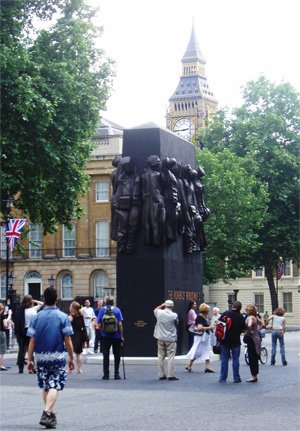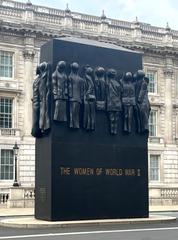
Visiting the Monument to the Women of World War II in London: Hours, Tickets, and Travel Tips
Date: 14/06/2025
Introduction
The Monument to the Women of World War II is a profound and visually arresting tribute in central London, honoring the more than seven million British women whose diverse contributions were essential to the Allied victory. Situated on Whitehall, close to landmarks such as the Cenotaph and Downing Street, the monument recognizes roles spanning military service, nursing, civil defense, agriculture, and industrial labor. Its evocative design, historical context, and prime location make it a vital stop for anyone interested in Britain’s wartime legacy and the evolving narrative of public remembrance (WAAF Association; Springer Link; Vilas Art Gallery).
This guide offers a comprehensive overview of the monument’s history, design, visitor information, travel tips, and its lasting cultural impact.
Table of Contents
- Historical Background and Path to Commemoration
- Design and Symbolism: Artistic Vision
- Location, Accessibility, and Visitor Information
- Travel Tips and Nearby Attractions
- Cultural Impact and Ongoing Legacy
- Frequently Asked Questions (FAQ)
- References
Historical Background and Path to Commemoration
Women’s unprecedented contributions during World War II spanned military enlistment in services like the ATS, WRNS, and WAAF, as well as vital roles in nursing, intelligence, munitions, and agriculture (WAAF Association). Despite their significance, these contributions long went under-recognized in Britain’s commemorative landscape, which was dominated by memorials to male military figures.
The campaign for a national memorial began in earnest in the late 20th century, fueled by veterans’ groups, women’s organizations, and public advocates. Baroness Betty Boothroyd, former Speaker of the House of Commons, spearheaded the initiative, drawing high-profile support and raising £1 million to fund the project. This campaign highlighted the nation’s overdue recognition of women’s vital wartime roles.
Design and Symbolism: Artistic Vision
Sculpted by John W. Mills and unveiled by Queen Elizabeth II on July 9, 2005, the monument is notable for its striking, minimalist design. It stands 22 feet (6.7 meters) high and features 17 sets of empty uniforms and outfits—ranging from military attire to nurses’ dresses and factory overalls—cast in bronze and suspended from pegs on a rectangular structure (Vilas Art Gallery; Traveling Old Folks).
This absence of human figures is a deliberate choice. The empty uniforms symbolize both the anonymity and universality of women’s wartime service, as well as the transition many made back to civilian life post-war. The monument’s design was inspired by a 1940s cloakroom photograph, capturing the moment when women would hang up their uniforms at the end of a shift. This artistic approach encourages visitors to reflect on the collective sacrifice and often uncelebrated labor of women during the war (Springer Link).
An inscription on the Portland stone plinth at the base reads: “The day is coming when all the women of the world will be free to be what they are…,” a quote by Dame Millicent Fawcett, linking women’s wartime efforts to the ongoing struggle for gender equality (Vilas Art Gallery).
Location, Accessibility, and Visitor Information
Location
- Address: Whitehall, London SW1A 2ET, United Kingdom
- Nearby landmarks: Cenotaph, Downing Street, Houses of Parliament, Trafalgar Square
Visiting Hours & Admission
- Open: 24 hours a day, 7 days a week
- Admission: Free; no tickets or advance booking required
Getting There
- By Underground: Westminster (Jubilee, District, and Circle lines) and Charing Cross (Bakerloo and Northern lines) stations are nearby.
- By Bus: Numerous routes serve Whitehall (including 11, 12, 24, 87, 88, 159, 453).
- On Foot: The monument is easily reached from Parliament Square, Trafalgar Square, and the Churchill War Rooms (Britain All Over; Atlas Obscura).
Accessibility
- The monument is fully wheelchair accessible, with smooth, level paving around it.
- No dedicated visitor center or on-site toilets, but facilities are available at nearby attractions.
Travel Tips and Nearby Attractions
Best Time to Visit:
Daylight hours are recommended for safety and the best viewing experience. Early mornings or late afternoons tend to be quieter, ideal for reflection and photography.
Photography:
The monument’s bronze surface and gold-lettered inscription photograph well, especially in natural light. Photography is permitted and encouraged.
Nearby Attractions:
- The Cenotaph: Britain’s main war memorial.
- Churchill War Rooms: A short walk away, offering immersive WWII history.
- Houses of Parliament & Big Ben: Iconic symbols of British democracy.
- Trafalgar Square & National Gallery: Art and culture within ten minutes’ walk.
- Horse Guards Parade: Site of ceremonial events and daily guard changes.
Guided Tours:
Many walking tours of Westminster and Whitehall include the monument as a key stop (GetYourGuide). Remembrance Sunday and International Women’s Day are especially poignant times to visit.
Visitor Safety:
Whitehall is a busy thoroughfare—use pedestrian crossings and remain on the pavements.
Cultural Impact and Ongoing Legacy
The Monument to the Women of World War II has become a focal point for national remembrance, educational visits, and public debate. Its design—empty uniforms rather than figures—invites reflection on both the presence and historical erasure of women in public memory (The F-Word). It has also sparked conversation about the need for more monuments that honor named women and diverse wartime experiences.
Ceremonies on Remembrance Sunday and International Women’s Day highlight its role as a living site of commemoration. The monument continues to influence discussions on gender and historical representation, inspiring further efforts to recognize women’s achievements in public spaces.
Frequently Asked Questions (FAQ)
Q: What are the monument’s visiting hours?
A: The monument is outdoors and accessible at all times, day and night.
Q: Is there an entrance fee or do I need tickets?
A: No, the monument is free and does not require tickets.
Q: Is the site wheelchair accessible?
A: Yes, the area around the monument is flat and suitable for wheelchair users.
Q: Can I take photographs?
A: Yes, photography is welcome.
Q: Are guided tours available?
A: Many local tour providers include the monument on Westminster and Whitehall walks.
Q: Are there any special events?
A: Remembrance Sunday and International Women’s Day often feature commemorative ceremonies at the monument.
Q: Are there visitor facilities on site?
A: No, but public toilets and cafés are available nearby in Trafalgar Square and Parliament Square.
References and Further Reading
Conclusion
The Monument to the Women of World War II is an essential destination for anyone seeking to understand Britain’s wartime history and the evolving story of public commemoration. Its innovative design and central location make it a powerful site of memory, reflection, and education. Combining a visit here with nearby historical attractions offers a fuller picture of London’s past and the roles played by women in shaping national identity.
For an enhanced experience, download the Audiala app for guided tours and real-time visitor tips, and follow us on social media for updates on events and new content about London’s historical sites.




















































































































































































































































